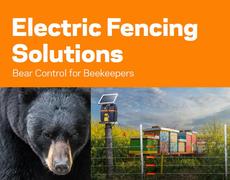As a bee keeper, Liz Goldie was aware she was setting up her hives in the bear populated area of Pincher Creek, located approximately 130 miles outside Calgary, Canada. Sitting east of the Canadian Rockies, the town is known for its variety of resident wildlife including black bears, grizzly bears, moose, and deer.

Goldie says she knew from the beginning that she would need to take security measures to protect her bees from predators when she moved to Pincher Creek.

"My neighbors informed me of the bear population in the area so I knew an electric fence would be in order," Goldie explains. She later added a video camera to monitor and track which unwanted guests were visiting her hives and when.
"The challenge with bee keeping is that you face a diversity of predators in all shapes and sizes – ants eat the honey, skunks eat the bees, and bears eat everything," she says.
Goldie became an expert in planning and constructing fences after her first fence was destroyed by a black bear.
"The bear circled the apiary, which includes seven hives, for 12 nights in a row," Goldie recalls. "Then it smashed through the fence, destroyed the posts and got to the beehives."

Goldie says in order to properly construct a fence system to deter bears you have to know a little about bears.
First, she positions the hives at least five feet from the fence so the bears are not able to reach over the wire and access the hives.
"Bears will also dig under your fence to get to the hives," she says. Goldie recommends stringing the bottom wire fairly low, approximately 2-6 inches from the ground. She then suggests placing a second line at about a foot high, then adding two or three more wires until the fence is at least four feet in height.
For posts, Goldie uses six foot wooden posts and spaces them no more than eight feet apart. She then puts braces in the corners and insulators at each post.

To ensure a highly-effective fence system, Goldie says selecting the proper amount of voltage is key.
"You'll want to select an energizer with a minimum of 6,000 volts," Goldie explains. "The purpose is to stop bears from reaching the hives. Getting stung by bees is not going to stop a hungry bear. They are drawn to the hives as it's a great source of food for them, especially in the late-summer and fall when they are looking to store energy for the winter."
Lastly, Goldie recommends purchasing a tester to ensure the fence is working properly.
"When we started using electric fencing, we didn't have a fence tester so my husband would touch the wires," says Goldie. "He quickly decided that it was worth the cost to invest in a proper fence tester."

Wise decision, says Eric Boyer, Gallagher territory manager. He recommends the company's cost-effective and top of the line Fault Finder.
"Gallagher's Fault Finder is very versatile as it measures voltage on all energizer types," explains Boyer.
"It measures up to 15KV and can be used without a ground lead for everyday fence voltage readings," he says. "The Fault Finder is also cordless and conveniently fits in your pocket. The large arrow display is easy to read and lasts up to three years on batteries that come included with the unit."
Whether it's honey bees, livestock or securing a property line, Goldie says protecting your assets from predators and unwanted visitors doesn't have to be difficult. "Regardless of the challenges you may face in your surroundings, with the right plan and the proper tools, you can achieve a highly-effective and long-lasting fence system."






 This is done through good grazing management which leaves adequate residual forage, in turn increasing litter cover on the soil surface and organic matter in the soil. Dominant forage species of pastures and rangelands can also be shifted to a more desirable, drought-resistant state by taking advantage of livestock's selective grazing tendencies.
This is done through good grazing management which leaves adequate residual forage, in turn increasing litter cover on the soil surface and organic matter in the soil. Dominant forage species of pastures and rangelands can also be shifted to a more desirable, drought-resistant state by taking advantage of livestock's selective grazing tendencies. Producers can use mapping tools such as Google Earth to create a 'living' map of their operation. Through this application it is possible to map fences, paddocks, and watering systems and track grazing moves. Many universities and ranch consulting firms offer free or low-cost training on how to use Google Earth for ranch mapping.
Producers can use mapping tools such as Google Earth to create a 'living' map of their operation. Through this application it is possible to map fences, paddocks, and watering systems and track grazing moves. Many universities and ranch consulting firms offer free or low-cost training on how to use Google Earth for ranch mapping. Additional online resources such as SNOTEL data from NRCS's National Water and Climate Center (
Additional online resources such as SNOTEL data from NRCS's National Water and Climate Center (









